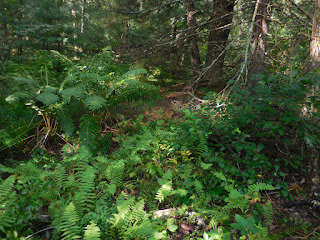 |
| Lygodium palmatum sporeling at five months old. |
In a previous post I talked about the biology and ecology of the Hartford Fern, Lygodium palmatum, America's lone native species of climbing fern. In this post I will discuss the process of growing this rare and botanically interesting plant from spores, which turns out to be relatively quick and unproblematic, as fern propagation goes.
Spores: Plant material of Lygodium palmatum is occasionally available from mail order nurseries, but the only regular source of spores that I am aware of is the American Fern Society's spore exchange, currently meticulously curated by Brian Aikins in Washington state. Spores could also be collected from mature plants in late autumn, if one happens to already have access to cultivated plants.
 |
| Lygodium palmatum, gametophyte (dark green) with one-leaved sporophyte emerging (light green). |
Soil: Hartford Fern grows in acidic soil, so I have used a light, acidic mixture of sphagnum peat moss and perlite for starting spores. I pasteurize small batches of soil in a microwave (on high for about five minutes), which helps to prevent or at least delay contamination of spore pots by algae and moss.
Sowing Spore: Lygodium spores are as fine as dust and must be sown on the surface of pots of soil, where they will be exposed to light. Temperate zone ferns like L. palmatum are best started in spring; no special pre-treatment, such as cold stratification, is needed. Ideally, spores should be sown thinly, so that the sporelings will have a little space between them, but this is difficult to accomplish. The soil is kept moist to wet by watering from below or with gentle misting, and the whole pot should be kept in a humid, closed environment in a plastic bag or terrarium. Bright but indirect light is best (such as in an east-facing window, or at the periphery of a grow light setup).
Germination and Sporeling Care: Lygodium spores germinate within a month or so, giving rise to crinkly, dark-green gametophytes. Gametophytes are the haploid (only one set of chromosomes), gamete-producing phase of the plant alternation of generations. The spore sowing mix has very little nutrient content on its own, so misting several times a month with half-strength water-soluble houseplant fertilizer is needed from germination on.
The gametophytes take several months to mature, at which point they produce sperm and eggs, fertilization takes place, and tiny, light-green leaves start to emerge from the undersides of the gametophytes. These light-green leaves are the young sporophytes, the diploid, spore-producing phase of the life cycle. In ferns, the sporophyte is the large, long-lived phase of the life cycle; what we typically think of as a fern plant.
The sporelings can be transplanted out to individual pots when the sporophytes have one or two fully expanded leaves and are about a centimeter or two across; this will probably be in summer, about four months after sowing. Transplants should be gradually adjusted to brighter sun and lower humidity, in preparation for overwintering the young plants in a cold greenhouse or sheltered position outdoors.
 |
| Lygodium palmatum, 6 month sporeling starting to put out dissected leaves. |















